The AMD Radeon R9 290 Review
by Ryan Smith on November 5, 2013 12:01 AM EST- Posted in
- GPUs
- AMD
- Radeon
- Hawaii
- Radeon 200
Crysis: Warhead
Up next is our legacy title for 2013/2014, Crysis: Warhead. The stand-alone expansion to 2007’s Crysis, at over 5 years old Crysis: Warhead can still beat most systems down. Crysis was intended to be future-looking as far as performance and visual quality goes, and it has clearly achieved that. We’ve only finally reached the point where single-GPU cards have come out that can hit 60fps at 1920 with 4xAA, never mind 2560 and beyond.
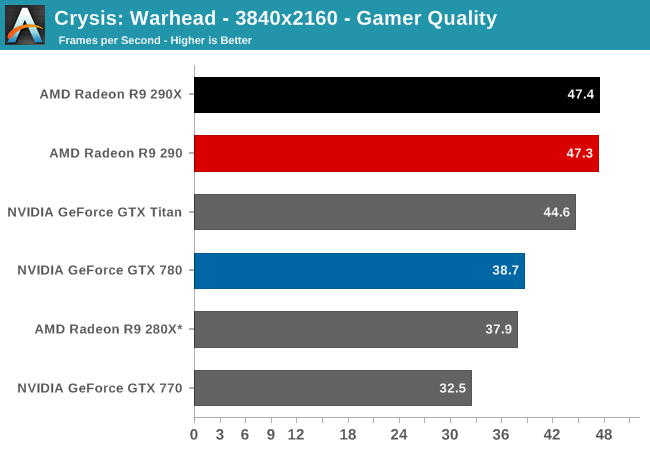
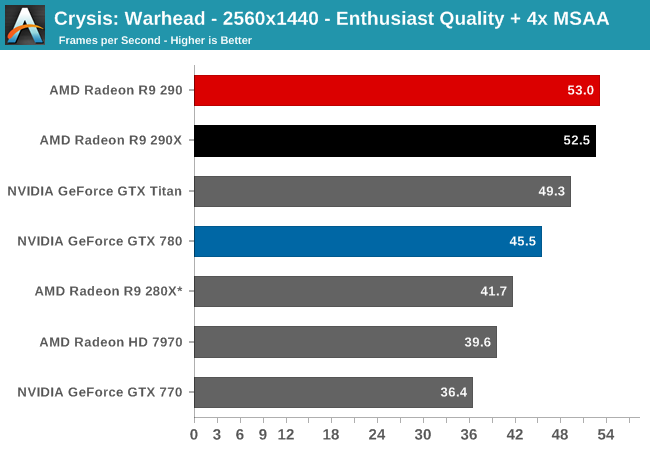
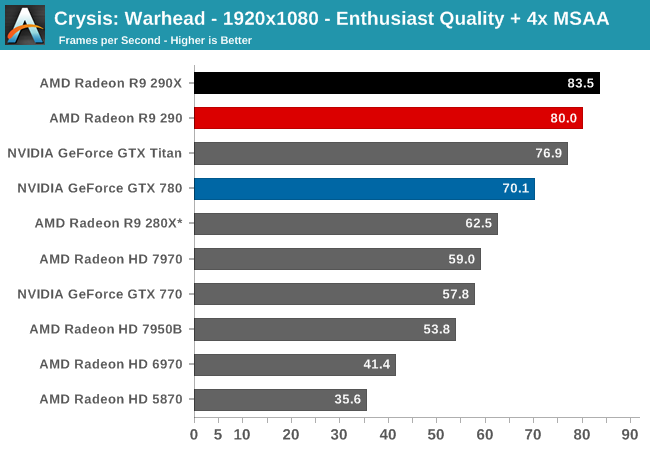
Unlike games such as Battlefield 3, AMD’s GCN cards have always excelled on Crysis: Warhead, and as a result it’s a good game for the 290 right off the bat. Furthermore because the 290X throttles so much here, coupled with this game’s love of ROP performance, the 290 actually beats the 290X, if only marginally so. .5fps is within our experimental variation (even though this benchmark is looped multiple times), but it just goes to show how close the 290 and 290X can be, and furthermore how powerful the higher average clockspeeds can be in ROP or geometry bound scenarios. Graphics rendering may be embarrassingly parallel in general, but sometimes a bit narrower and a bit higher clocked can be the path to better performance.
Meanwhile because the 290 does so well here, it makes for another sizable victory over the GTX 780, beating it by 16%. Further down the line the GTX 770 is beaten by 46%, and the 280X by 27%.
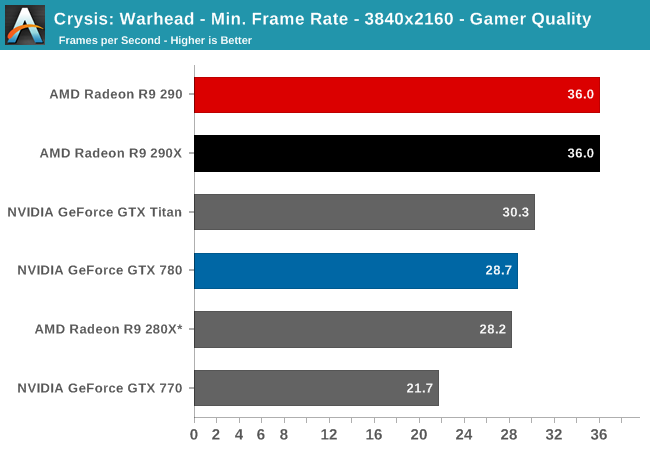
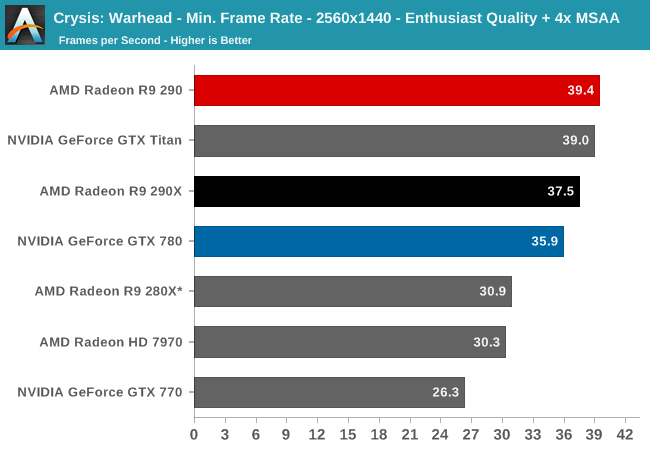
Moving on to our minimum framerates, the 290 actually extends its lead over the 290X. Now minimum framerates aren’t as reliable as average framerates, even in Crysis, so our experimental variation is going to be higher here, but it does once again show the advantages the 290 enjoys being clocked higher than the 290X under a sustained workload. Though on the other hand the GTX 780 catches up slightly, closing the gap to 10%.










295 Comments
View All Comments
mattgmann - Tuesday, November 5, 2013 - link
I'd really like to see some benchmarks with this and the 290x under water.For someone like me that has already invested in building a water cooling setup and seen a few generations of hardware pass through it, the idea of watercooling the graphics card is a foregone conclusion.
The only added cost to me in upgrading the cooling is a few dollars worth of memory and other heatsinks to put on the card since I'd be using a universal gpu block.
I have a feeling that with the thermal levels in check, these cards will probably perform a good bit quicker than they already do (and that much more than the competition).
supamark - Tuesday, November 5, 2013 - link
"At the end of the day the 290 is 9.7dB louder than its intended competition, the GTX 780. With a 10dB difference representing a two-fold increase in noise on a human perceptual basis, the 290 is essentially twice as loud as the GTX 780."Un, no. Learn to dB... 3 dB would mean it's twice as loud, 10 dB means it's 10x as loud, the decibel is a log scale.
NomanA - Tuesday, November 5, 2013 - link
Human audio perception is also on a somewhat logarithmic scale. Twice as loud, doesn't mean, two times a certain value on a linear scale.supamark - Tuesday, November 5, 2013 - link
Sorry, but 3 dB is twice as loud. 10 dB, aka 1 Bel, is 10 times as loud. You hear 3 dB as twice as loud. You should just read this.... (3rd paragraph) instead of arguing.http://en.wikipedia.org/wiki/Decibel
kiwidude - Tuesday, November 5, 2013 - link
You are incorrect, 3dB represents a ratio of two to one or a doubling of power. Perception of loudness is not the same as sound pressure level or power. An increase of 10db SPL is perceived to be approximately twice as loud.I suggest you read instead of arguing. http://trace.wisc.edu/docs/2004-About-dB/
Sancus - Wednesday, November 6, 2013 - link
You're talking about power. Ryan Smith is talking about perceptual loudness. They're completely different. 10db does NOT sound 10 times as loud to your ear. It merely represents ten times as much power.http://trace.wisc.edu/docs/2004-About-dB/
piroroadkill - Wednesday, November 6, 2013 - link
You would need to start talking about human-hearing-weighted scales at that point to get any kind of "X as loud" to us, type measurements. Which is where dBA is often the go to scale.philosofa - Tuesday, November 5, 2013 - link
Don't quote me regulations. I co-chaired the committee that reviewed the recommendation to revise the color of the book that regulation's in. We kept it gray.Excellent editing ser :)
dudeofdur - Tuesday, November 5, 2013 - link
bracket + closed loop water cooler. Boom, solved your problemTorm - Tuesday, November 5, 2013 - link
It is sad when a review is so biased, that the reviewer doesn't appreciate extra performance. If you prefer a quiet card, turn the fan speed down. You are here to review the performance, and while the noise level is taken into consideration, in your final thoughts, you never once say "While the may be loud, you can always adjust fan levels to find the right sound for you." This card, by performance numbers, should have been a very high recommendation, with a note on it being loud. You decided in the review of the card, that you had rather recommend against it, as opposed to being honest. While I tested the card, I found it loud yes, but I also found that if I was an "Average" consumer, who will have their computer case sitting at least 2-3 feet from them, and listening to the audio of a game, movie, or music, that the audio difference between it and the 780 is barely noticed. This is a good review ruined by Biased minded comments. If you are looking for one of the best cards out there, and the BEST value for your money. This card IS it. Bar None. Just to be clear. I am a Hardcore Titan fan, but if I were to build a PC today, this would be the card I went with.